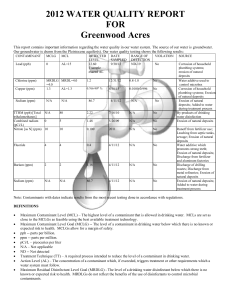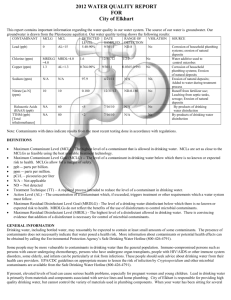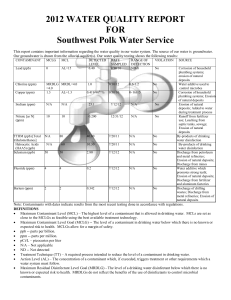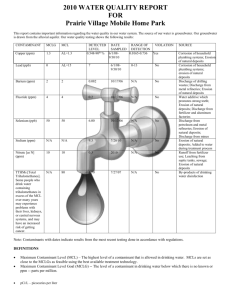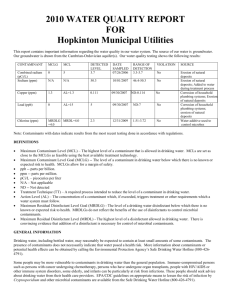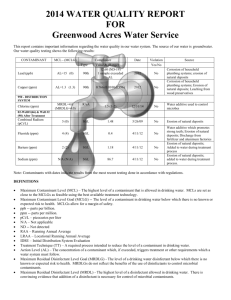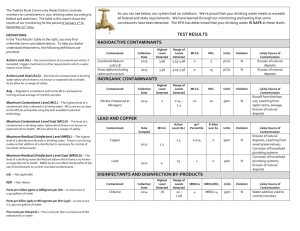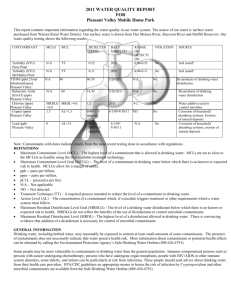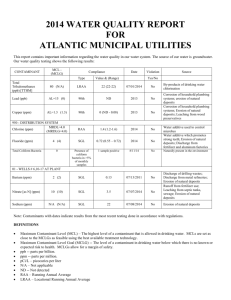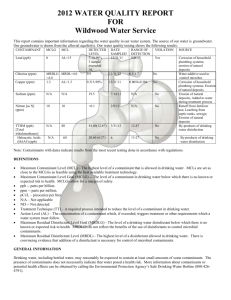2011 Consumer Confidence Report
advertisement
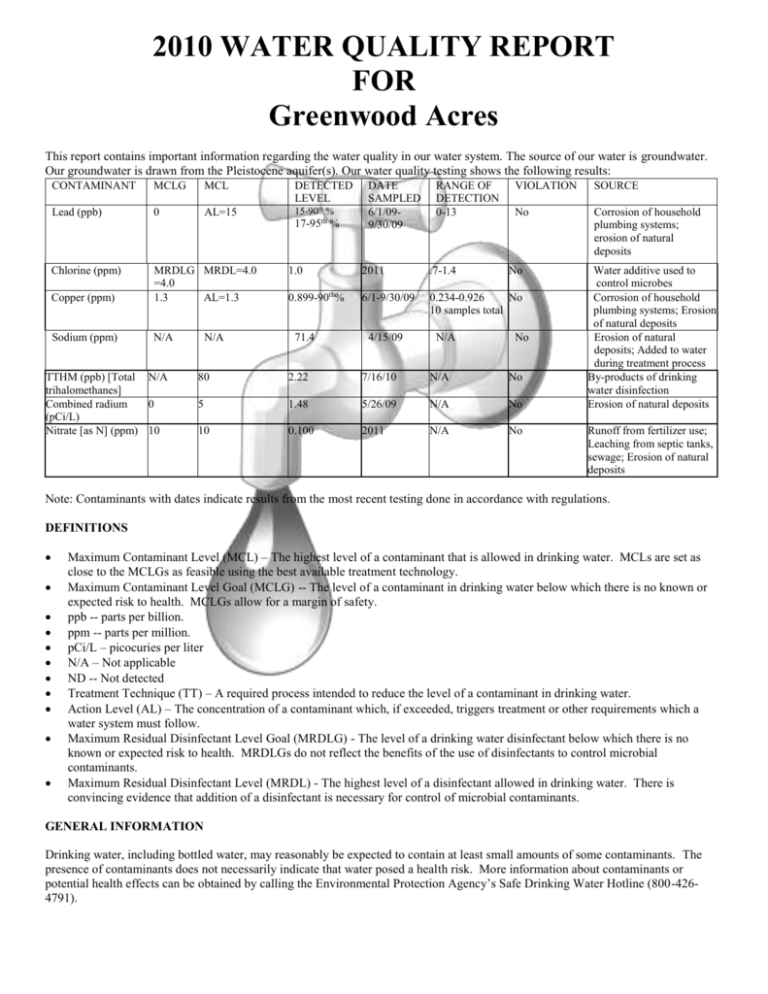
2010 WATER QUALITY REPORT FOR Greenwood Acres This report contains important information regarding the water quality in our water system. The source of our water is groundwater. Our groundwater is drawn from the Pleistocene aquifer(s). Our water quality testing shows the following results: CONTAMINANT MCLG MCL DETECTED LEVEL Lead (ppb) 0 AL=15 15-90th % 17-95th % Chlorine (ppm) Copper (ppm) MRDLG MRDL=4.0 =4.0 1.3 AL=1.3 Sodium (ppm) N/A TTHM (ppb) [Total N/A trihalomethanes] Combined radium 0 (pCi/L) Nitrate [as N] (ppm) 10 N/A DATE SAMPLED 6/1/099/30/09 RANGE OF DETECTION 0-13 VIOLATION SOURCE No Corrosion of household plumbing systems; erosion of natural deposits 1.0 2011 .7-1.4 0.899-90th% 6/1-9/30/09 0.234-0.926 No 10 samples total 71.4 4/15/09 N/A No No 80 2.22 7/16/10 N/A No 5 1.48 5/26/09 N/A No 10 0.100 2011 N/A No Water additive used to control microbes Corrosion of household plumbing systems; Erosion of natural deposits Erosion of natural deposits; Added to water during treatment process By-products of drinking water disinfection Erosion of natural deposits Runoff from fertilizer use; Leaching from septic tanks, sewage; Erosion of natural deposits Note: Contaminants with dates indicate results from the most recent testing done in accordance with regulations. DEFINITIONS Maximum Contaminant Level (MCL) – The highest level of a contaminant that is allowed in drinking water. MCLs are set as close to the MCLGs as feasible using the best available treatment technology. Maximum Contaminant Level Goal (MCLG) -- The level of a contaminant in drinking water below which there is no known or expected risk to health. MCLGs allow for a margin of safety. ppb -- parts per billion. ppm -- parts per million. pCi/L – picocuries per liter N/A – Not applicable ND -- Not detected Treatment Technique (TT) – A required process intended to reduce the level of a contaminant in drinking water. Action Level (AL) – The concentration of a contaminant which, if exceeded, triggers treatment or other requirements which a water system must follow. Maximum Residual Disinfectant Level Goal (MRDLG) - The level of a drinking water disinfectant below which there is no known or expected risk to health. MRDLGs do not reflect the benefits of the use of disinfectants to control microbial contaminants. Maximum Residual Disinfectant Level (MRDL) - The highest level of a disinfectant allowed in drinking water. There is convincing evidence that addition of a disinfectant is necessary for control of microbial contaminants. GENERAL INFORMATION Drinking water, including bottled water, may reasonably be expected to contain at least small amounts of some contaminants. The presence of contaminants does not necessarily indicate that water posed a health risk. More information about contaminants or potential health effects can be obtained by calling the Environmental Protection Agency’s Safe Drinking Water Hotline (800-4264791). Some people may be more vulnerable to contaminants in drinking water than the general population. Immuno-compromised persons such as persons with cancer undergoing chemotherapy, persons who have undergone organ transplants, people with HIV/AIDS or other immune system disorders, some elderly, and infants can be particularly at risk from infections. These people should seek advice about drinking water from their health care providers. EPA/CDC guidelines on appropriate means to lessen the risk of infection by Cryptosporidium and other microbial contaminants are available from the Safe Drinking Water Hotline (800-426-4791). If present, elevated levels of lead can cause serious health problems, especially for pregnant women and young children. Lead in drinking water is primarily from materials and components associated with service lines and home plumbing. Greenwood Acres is responsible for providing high quality drinking water, but cannot control the variety of materials used in plumbing components. When your water has been sitting for several hours, you can minimize the potential for lead exposure by flushing your tap for 30 seconds to 2 minutes before using water for drinking or cooking. If you are concerned about lead in your water, you may wish to have your water tested. Information on lead in drinking water, testing methods and steps you can take to minimize exposure is available from the Safe Drinking Water Hotline or at http://www.epa.gov/safewater/lead. CONTAMINANT VIOLATIONS None. ADDITIONAL HEALTH INFORMATION Chlorine. Some people who use water containing chlorine well in excess of the MRDL could experience irritating effects to their eyes and nose. Some people who drink water containing chlorine well in excess of the MRDL could experience stomach discomfort. Lead. Infants and children who drink water containing lead in excess of the action level could experience delays in their physical or mental development. Children could show slight deficits in attention span and learning abilities. Adults who drink this water over many years could develop kidney problems or, high blood pressure. Nitrate. Infants below the age of six months who drink water containing nitrate in excess of the MCL could become seriously ill and, if untreated, may die. Symptoms include shortness of breath and blue-baby syndrome. TTHMs [Total Trihalomethanes]. Some people who drink water containing trihalomethanes in excess of the MCL over many years may experience problems with their liver, kidneys, or central nervous systems, and may have an increased risk of getting cancer. OTHER VIOLATIONS The system had no additional violations. SOURCE WATER ASSESSMENT INFORMATION The Greenwood Acres water supply obtains its water from the groundwater aquifer. The Pleistocene aquifer was determined to be low susceptibility to contamination because the characteristics of the aquifer and overlying materials limit the rate at which contaminants can move through the aquifer. The wells will not be susceptible to most contaminant sources except through pathways to the aquifer such as abandoned or poorly maintained wells. A detailed evaluation of your source water was completed by the IDNR, and is available from Greenwood Acres at 289-2345. CONTACT INFORMATION For questions regarding this information, please contact Tom Thorpe at Water Development Co (515) 289-2345 during the following hours: Mon-Fri., 8:00 a.m.-4:00 p.m.


